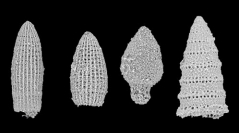

 Comptes Rendus Palevol
7 (6) - Pages 327-334
Comptes Rendus Palevol
7 (6) - Pages 327-334The Vedi ophiolite, situated southeast of Yerevan (Armenia), represents part of the Neotethyan oceanic lithosphere preserved in the Lesser Caucasus. This ophiolite unit constitutes a large tectonic klippe, a result of obduction during the Upper Cretaceous (Coniacian–Santonian). Relatively well-preserved Radiolaria extracted from radiolarites overlying ophiolitic lavas along the Vedi River consist of Middle Jurassic (Bajocian, U.A.Z. 3–4) species, typical of the Tethyan tropical bioprovince. Assemblages are dominated by Nassellaria and characterised by the presence of species Cyrtocapsa mastoidea, Hexasaturnalis hexagonus, Laxtorum (?) hichioense, Stichocapsa japonica and Striatojaponocapsa plicarum s.l. This microfauna provides evidence for the oldest age available so far for the sedimentary cover of the Vedi ophiolite.
Radiolaria, Radiolarites, Lesser Caucasus, Armenia, Vedi ophiolite